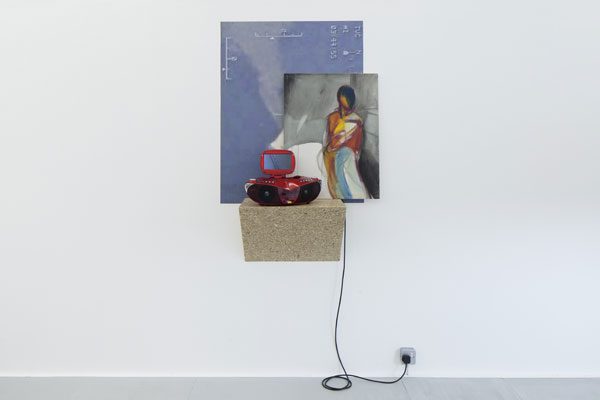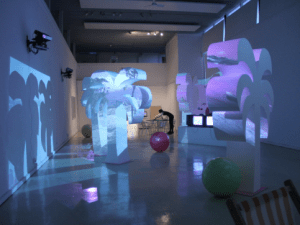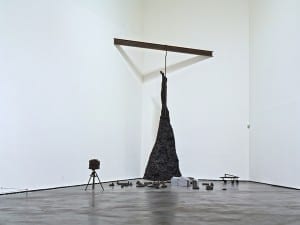Young Gods is a multi-disciplinary presentation of London’s most exciting graduates from the summer of 2012. Curated by Zavier Ellis, director of Shoreditch gallery CHARLIE SMITH london and co-founder of THE FUTURE CAN WAIT, the artists are selected based on their innovation and artistic promise. The exhibition takes place simultaneously across two locations in west and east London, at the Griffin Gallery and CHARLIE SMITH london until 16 February. Aesthetica speaks to one of the selected artists, Christopher Kulendran Thomas, who presents his work, When Platitudes Become Form. Born in London after his parents fled Sri Lanka, the artist’s work offers a unique approach to contemporary art and engages with his Sri Lankan heritage.
A: Please can you explain the premise of When Platitudes Become Form?
CKT: This ongoing enterprise reconfigures for the international (Western) market artworks by some of Sri Lanka’s foremost young contemporary artists.
A: Is this reconfiguration down to a dissatisfaction with their art or an active response to their work?
CKT: Purchasing artworks through Sri Lanka’s most prominent new gallerists, rather than dealing with the artists themselves, I physically translate what counts as “contemporary” in Sri Lanka into what is expected of the “contemporary” at the heart of art-imperial power and then exploit the difference to set something else in motion, something that might exceed the parameters of contemporary art.
A: You also use your work to raise funds to resist the oppression of communities displaced by civil war, does your work represent their struggles at all?
CKT: I’m more interested in what it does than what it represents. The overall composition of this work takes as its materials the whole system by which art is distributed. Sri Lanka’s civil war ended in 2009 as the island’s government leveraged international interests to comprehensively defeat the Tamil Tigers. Now, as the North and East of the country are about to be sold off to the international backers of that victory, the economy is booming and with it a new context of Contemporary Art has emerged. The capital Colombo’s first Western-style commercial galleries have very quickly established Contemporary Art – as in the West – as the highest benchmark of connoisseurial consumerism in what is now one of the world’s fastest growing small economies.
So, counter-manipulating the forces of globalisation, When Platitudes Become Form is an attempt to undercut the parameters of Contemporary Art through what philosopher Reza Negarestani might call a rigorous excavation of the ethics of humiliation. The patronising openness of instrumentalised cultural exchange is explicitly perverted here by the colonial trading patterns that it usually masks, setting in motion a conspiracy of contingencies that extend beyond the work’s as yet visible horizons.
A: How has your Sri Lankan heritage had an impact on your work?
CKT: My parents fled Sri Lanka amidst escalating civil conflict, arriving in Britain in the 1970s to make a new life for themselves. My Dad’s first job in London was in a British Leyland tyre plant and, for a while, he used to sleep inside the giant lorry tyres. My sister and I were born in London and brought up completely immersed in British culture, without any real context for our Sri Lankan heritage. It must have been hard for my parents, as it must be for any refugees of conflict, to see their kids grow up so far from their roots. I suppose When Platitudes Become Form is an attempt on my part to come to terms with my distance from the visual culture of Sri Lanka. But I try to do that in a way that is appropriately antagonistic and just as conflicted as the realities of the residues of empire. In a way I see this work as a small way of reverse engineering the processes of globalisation that have decimated the Tamil nation.
A: What does it mean to you to be part of Young Gods?
CKT: I like some of the artists that have taken part in past years, like Alexis Milne, and it’s nice to be thought of in their company and also with some of the artists with whom I have studied on the Fine Art MFA at Goldsmiths, like Andrew Leventis and Salome Ghazanfari, whose work I really dig.
A: What are you working on in the future?
CKT: A variety of things: making some art, doing some shows, talking some talks. The next phase of When Platitudes Become Form will be to establish a globally networked platform for participatory filmmaking based on Augusto Boal’s Forum Theatre methodology. I’m about to give a lecture with Ben Vickers on Art After the Internet as part of the MFA lecture series at Goldsmiths, which I’m pretty nervous about because I used to give a hard time to visiting lecturers when I was on the MFA. And, with curator Tom Trevatt, I’ll be speaking about art beyond spectatorship at the 4th Former West conference in Berlin this March. My next solo shows will be opening on 15 March at Kraupa-Tuskany Zeidler (Berlin) and on 2 May at the Centre for Contemporary Art (Tel Aviv). I will also be curating a show called Plants vs Zombies at Boetzelaer|Nispen (Amsterdam) opening 23 February and I’m about to start converting an old hair salon in Peckham into an exhibition space, opening later this year.
Christopher Kulendran Thomas: When Platitudes Become Form, Young Gods, Until 15 February, The Griffin Gallery, The Studio Building, 21 Evesham Street, London, W11 4AJ.
Credits
All works by Christopher Kulendran Thomas. All photo credits: Joe Clark.
1. From When Platitudes Become Form, Video, Sound, USB flash drive, portable media player, wood, poster and print and Unknown Woman (2011) by Ruwan Prasana (purchased from Saskia Fernando Gallery, Colombo Sri Lanka).
2. From When Platitudes Become Form, Record Player, vinyl, perspex, wood electronics and Mother Love (2010) by Arun Senanayake (purchased from Arteria Gallery, Colombo, Sri Lanka).
3. From When Platitudes Become Form, One way mirrored vitrine, fluorescent lighting, steel, expanding foam and Universal Power (2011) by Jegan Weerasinghe (purchased from Saskia Fernando Gallery, Colombo Sri Lanka).





